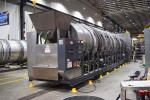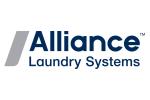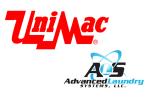CHICAGO — Upgrades are a constant in the laundry and linen services industry.
Some operations need to improve quality and efficiency. Others have acquired older facilities in desperate need of upgrades.
Sometimes equipment simply wears out.
Costs, labor issues, government regulations … there are many reasons for industrial laundries to update equipment and facilities.
American Laundry News reached out to several laundry operators and equipment manufacturers to find out which upgrades have been requested most recently, the reasons for the upgrades and how operations have been improved.
COMMERCIAL LAUNDRY EXAMPLES
Pamela Barnett, project manager for Core Linen Services (formerly Crothall Laundry Services), which has 14 full-service commercial laundry plants across the United States, says that the company has made upgrades at its facilities in Columbia, South Carolina; Johnson City, Tennessee; and Phoenix.
“With state-of-the-art equipment from JENSEN and Kannegiesser ETECH, we’ve installed new tunnels, wash aisles, (Chicago Dryer Co.) Blanket Blasters and more at our facilities,” she shares. “In addition to upgrades completed on the clean side, we have taken steps to optimize the soil sort processing to ensure maximum efficiency.
“These plants now utilize the latest laundry technology to ensure precision and quality in every product processed.”
Barnett says the driving purpose behind everything Core does, including equipment and facility upgrades, is to remain an industry leader by providing outstanding quality, excellent customer service, and a safe and efficient workplace.
“We consistently look for ways to accomplish this by being proactive in our approach to equipment and maintenance needs,” she says.
“Managing costs effectively is crucial for maintaining competitiveness in the market. We strive to become the most efficient laundry operation by reducing our costs while maintaining a high level of quality products and service to our customers.”
Overall, Barnett says the upgrades have streamlined productivity and maximized efficiency.
“New and added equipment like the Blasters have added approximately 25% better throughput,” she shares. “Our commitment to sustainability and energy efficiency has also resulted in methods that reduce water consumption and lower our carbon footprint.”
NOVO Health Services, which is headquartered in Atlanta, upgraded full plant rail control systems and both soil side and clean side processing operations in its Dubois, Pennsylvania, facility.
“We made the decision to upgrade these controls to enhance efficiency, reduce potential downtime and meet growing demands,” says Shane Ledbetter, senior vice president of operations.
“The new equipment offers advanced features such as increased throughput, higher precision, and greater reliability, enabling the facility to optimize production processes and remain competitive in the market.
“Additionally, the upgrade aligns with NOVO’s commitment to ongoing innovation and continuous quality improvement, implementing the most sophisticated and efficient equipment available to better serve our healthcare customers and keep their costs down.”
Ledbetter says that a project of this scope and magnitude had the potential to challenge the plant’s ability to maintain consistent service levels and continue to achieve 100% on-time order fulfillment given the fact that the entire material handling system had to be taken offline for these upgrades.
“As such, we methodically planned the plant’s processing capability in the days leading up to the installation to prepare product and limit service interruptions while the plant was offline,” he points out.
“While this increased the overall cost of this project, it was necessary to ensure our healthcare customers felt no impact with regard to quality levels, turnaround time and patient satisfaction.”
Ledbetter shares that the upgrade has significantly bolstered reliability and service levels across the company’s operations.
“This upgrade has brought about a notable improvement in performance, minimizing downtime and enhancing overall efficiency and quality,” he says.
“With the implementation of this state-of-the-art technology, we’ve experienced fewer system failures and disruptions, leading to smoother operations and increased customer satisfaction.
“The upgraded equipment has also enabled us to deliver our services with greater speed, meeting and even surpassing the expectations of our customers.
“This enhancement not only strengthens our reliability but also underscores our commitment to providing exceptional service to our healthcare customers, their staff and their patients.”
Check back Thursday for more recent upgrades shared by two manufacturers.
Have a question or comment? E-mail our editor Matt Poe at [email protected].



























